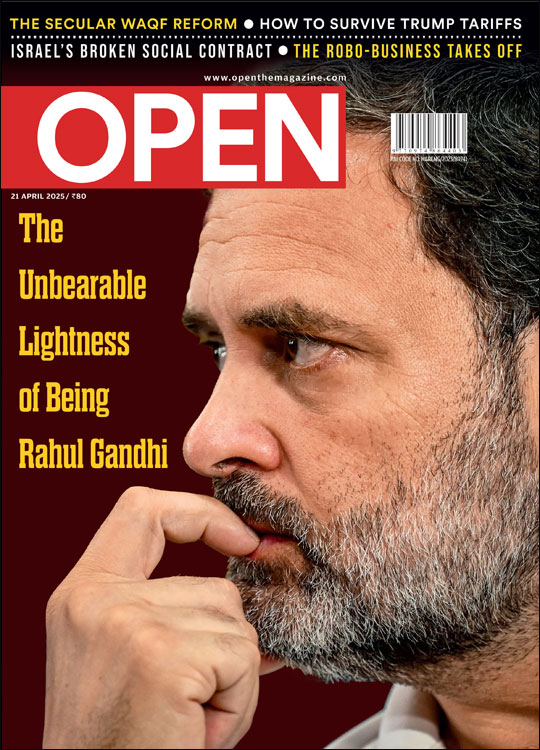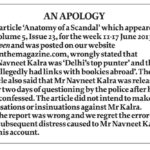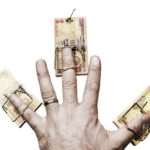HELL ON THE HIGH SEAS
As the last of the Indian sailors held by Somalian pirates return home, survivors relive the horrors of being held hostage for years
 Madhavankutty Pillai
Madhavankutty Pillai
 Madhavankutty Pillai
Madhavankutty Pillai
 |
27 Nov, 2014
|
27 Nov, 2014
/wp-content/uploads/2015/11/Pirates-highsea1.jpg)
As the last of the Indian sailors held by Somalian pirates return home, survivors relive the horrors of being held hostage for years
It was a little after 9 at night on 28 September 2010 when the general alarm rang aboard MV Asphalt Venture. The cargo ship on its way to South Africa was in the Somali basin and Bhim Sen Singh, the electrical officer who rushed to the quarterdeck area and saw guns being fired, guessed that it was a pirate attack. He went below to the control room, where everyone agreed that should pirates come aboard, they would raise their hands. As expected, a man came holding an AK-47 and they followed him to the bridge where the rest of the crew were assembled. They were told the ship was being taken to Somalia and as soon as its owner paid the ransom, everyone would be freed. “He told us not to worry,” says Singh. That turned out to be an understatement.
On 3 October 2010, the ship dropped anchor near the Somalian coast. It would be four years before Bhim Sen Singh and six others would see India again, a period during which they would be tortured, starved and made to live in animal-like conditions always a breath away from death.
This was not the first time that pirates had held Indians hostages, but two things mark out the story of the seven Indian crew who returned last month, physically and mentally mere shadows of the men they once were. The first was that they were the last of the Indian sailors in captivity in Somalia. The second is that they should have been released three years ago when the ship’s owner did pay a ransom, but, unusually, the pirates didn’t keep their word. While eight others had been freed along with the ship then, these seven were held back at the last minute.
Once anchored in Somalian waters, it wasn’t an easy time for Singh. “Everything on the ship runs on a generator. The diesel was getting over. Because I was the electrical officer, they would always put a gun to me and ask why there was no power supply,” he says. The generator also kept breaking down. “The batteries had gone and needed to be charged. I had to keep adjusting to keep everything operational.” Two emergency boats had four batteries and Singh kept them aside without telling the pirates. “I risked my life to keep these batteries. I used them in the last month to run the generator,” he says.
After six months of captivity, the crew learnt that a deal had been made and their release was imminent. The ship’s chief engineer, Bahadur Singh, remembers that day well. Being a senior officer, he had been regularly tortured, a tactic used to turn the crew pliant and also force the ship’s owner to accede to their demands. “The captain and I were put together in a cabin. Someone would knock on the door and the cocking of the gun would be heard. There was always the fear that they would come in and shoot us,” he says.
The day they were to be released, Bahadur Singh had been in the engine room with his team getting the ship ready. “Parts of the engine, like nozzles and injectors, were being fitted. We were to leave in an hour and a half,” he says. Suddenly, a few pirates came and started marking out some of them. “They separated us, forced us into a boat, and firing in the air, took us to the shore,” he says. They were herded into vehicles which sped off. Behind them, over the sea, a chartered plane came and dropped the ransom. The ship and a part of the crew left with their freedom.
After some hours, they were let out in a forest and told that they had been kept as trading chips for Somali pirates in Indian jails. The next day a tent was brought for them to live in. “Every few months they would shift us to different places within a two to three kilometre radius,” says Bahadur Singh. Provisions were at subsistence levels. About 40-50 litres of water was given daily for the hostages and four pirates guarding them. Bathing, cooking, drinking and so on had to be managed on that. When it rained, they dug holes and lined these with tarpaulin to collect extra water. For food, they got a little flour, rice and salt. They would cut wood to cook. “If we asked for something, they would point a gun and threaten to shoot,” says Bhim Sen Singh.
Bahadur Singh remembers one hostage, a Sikh, being asked to cut his beard because one pirate thought he looked like a terrorist. The group Al Sabah, an Al Qaeda offshoot, was active there and the pirates were afraid of them. The Sikh refused. “He was tied up as punishment. We decided that we will not make food,” says Bahadur Singh. The protest worked because the commander replaced the pirate. Once, one of the hostages fell very ill with swollen legs and bloodshot eyes. It was only after a month that he was taken to a doctor in a nearby town. Danger was ever present. The pirates were not trained to use firearms and often fired by mistake. “There were lots of times when bullets flew by our side or over us,” says Bhim Sen Singh. “We must have killed a hundred snakes there.”
A typical day in captivity was about doing nothing except eat, cook, sleep and pray. “We became silent after some time and no one talked very much to each other,” he says. Time passed; 2010 turned to 2011, and 2012 came and went, then it was 2013. That year, the pirates said they weren’t interested in freeing the jailed pirates in India and asked them to tell the shipping company to pay for their release. But the company, which had already paid a ransom once, was reluctant. Slowly, they began to feel that they would never be free again.
Their first sign of hope was on 17 September this year when Chirag Bahri of the Maritime Piracy Humanitarian Response Programme (MPHRP), an organisation that works to help captured sailors, spoke to them over telephone and asked each one their personal details. “We realised he was asking to confirm if we were all alive and so something was happening,” says Bhim Sen Singh.
The MPHRP is an NGO registered in the UK and came formally into existence in 2011 after there was a spurt in the number of ships captured at sea by Somali pirates in 2009, 2010 and 2011. “People were talking about the loss to shipping and insurance companies. No one was talking of the condition of seafarers,” says MPHRP’s Bahri.
In India, he started work on this front in April 2012. “We formed a small programme staging group that includes industry, unions, professional bodies like marine engineers… people who are worried for seafarers. We meet once in three months to assess what is the present condition on piracy. We try and see that we are there for every seafarer affected by piracy,” he says.
Bahri had been in regular touch with the families of the Asphalt Venture hostages and understood their anguish—he had been a hostage himself for eight months. In 2010, he had been a second engineer on a chemical tanker going from Kandla to Belgium via the Gulf of Aden when pirates attacked. The ship, fully loaded, was about three metres above the waters and all the pirates needed to do was hook a ladder. It took them just 20 minutes to board and take control of the ship. They turned it towards Somalia. Once there, a negotiator came on board who assessed the condition of the ship, the status of the owner, what the cargo was, and the nationality of the crew. Based on all these, he arrived at a ransom amount and negotiations started. Bahri says that this can be a gruelling and frustrating exercise.
“If you want to buy a car for which Rs 5 lakh is being asked, you say you are ready to pay four, and then both parties settle for 4.3. But it doesn’t happen like that in Somalia. If the pirates demand $10, the company will say $8. But the pirate will now think, ‘I am stupid, I should have asked more.’ The next day, their demand will be $20. They will keep on increasing it like this.” The strategy of the shipping company then becomes to break the hope of pirates of getting anything so that they settle for the minimum. The company will start with offering 10-20 per cent of the initial demand. Pirates, meanwhile, realise that the longer they hold hostages, the more they could make the company shell out. While this tug-of-war goes on, the hostages would crumble mentally and physically.
On Bahri’s ship, food and water soon ran out. The vessel had a fresh water manufacturing system and they modified it to run on stand-by engines to produce three to four tonnes of water in a day. This gave the pirates an idea. In that area there were about 10 vessels hijacked by different groups that didn’t have easy access to fresh water because they couldn’t produce it on standby engines. The pirates aboard Bahri’s ship decided to supply fresh water in barter for other things they needed. “But we were finishing our fuel by running our generators to make the water,” says Bahri. The depletion made the pirates suspicious because they had no comprehension of how systems worked. “They started beating those who were responsible for the engine rooms. Bullets were fired near the chief engineer’s ears. They put a blindfold on us and threatened to shoot if we didn’t reveal where the fuel was going,” says Bahri. When the crew updated their logbooks, the pirates would poke them with guns to say what they were writing. “Every single minute in captivity is like death near you,” says Bahri.
The machinery started developing hiccups and they were accused of doing it on purpose. The pirates wanted all the light bulbs running at night because they were afraid other groups might attack them. When the bulbs fused, the crew would again get beaten up. “Beatings, torture, pointing guns at us, firing in the air… all this was absolutely normal as part of the daily routine,” says Bahri. Once they were forced to enter tanks where hazardous gases spewed to see if there was fuel in them. “We went without any ventilation; luckily we survived,” he says.
When negotiations hit a roadblock, the torture increased. “They tied our hands and legs together in the back and left us like that for hours. They tied the genitals of one of us. They put the chief engineer and captain in the meat room in minus 17 degrees temperature. They hanged the Master, who was 55 years old, upside down and beat him badly. The chief engineer was thrown into the sea with one leg tied and then pulled up,” says Bahri.
The company paid the ransom in December 2010, dropping it in bags near the ship. It was collected and the pirates distributed it among themselves and went away, leaving the ship and the crew free. The major chunk of the ransom goes to a financier who funds the operation. “He does not come on board often. Maybe three or four times. He appoints leaders on board who call themselves commanders,” says Bahri.
Bahri had injuries all over when he was released and had to undergo physiotherapy for months. “Even now, my fingers tremble sometimes,” he says. When he came back, he found that his mother was no more; she had passed away from the anguish. It took Bahri a year to recover from the mental, physical and emotional trauma. But then whenever he heard of other piracies in which Indians were held hostage, he would reach out to the families to offer moral support. “They used to come on the media and then I would contact the channels to get in touch and give them support, saying that their son will be okay,” he says. This brought him to the notice of the MPHRP, which was drafting its programme at the time. Bahri helped the organisation out with information such as the contact details of captive seafarers. The MPHRP later asked him to join it and he is now its regional director for South Asia.
Bahri has little to do if the pirated ship happens to belong to a company that cares for its employees. “Our main work starts where the companies do not respond,” he says. In the case of Asphalt Venture, many of the families of the hostages had no income. Bahri coordinated efforts with the Indian Government to get them financial support. He also organised jobs for some of them by liaising with the maritime industry. The MPHRP also played an important part in getting the hostages released, though it does not directly negotiate with pirates. “We just give humanitarian support. We have partners who support us in different ways. Some of them are professionals in negotiation and we use their services,” says Bahri. And once the released sailors feel they are ready to get back to work, Bahri makes it a point to try helping them again.
One piracy case that Bahri mentions of how things can go terribly wrong is of the ship MV Iceberg 1. Jaswinder Singh, who was part of the crew, witnessed the horror first-hand over three years. On 29 March 2010, Iceberg 1 was off the coast of Yemen and Jaswinder Singh was on duty in the early morning 4-to-8 shift. He had gone to wake up the next shift and was coming back when the alarm rang and the pirates boarded. Once in Somalia, negotiations with the owner stretched on and, in between, the pirates came up with another plan of using the vessel as a mothership to capture other ships.
For about two months, they made preparations, getting fuel and speed boats, and then left towards the Gulf of Oman with more than 50 pirates armed to the teeth. “On the fourth day, we came across a warship that made us turn back. We sailed for two more days and again encountered a French warship. We came back to Somalia and put down anchor,” says Jaswinder Singh.
Talks resumed with the owner, but there was no breakthrough. After a few months, the pirates again decided to head for the sea using the Iceberg as a mothership. The ship’s condition had deteriorated by then. Two anchors had broken off because the sea bottom was sand and didn’t allow a proper grip. Diesel and water were exhausted and the crew would get beaten up for it. When they were planning to sail to another town for provisions, the third spare anchor also broke down. They procured a fourth anchor from another ship, but then there was a fire in the engine. The chief engineer was asked to start the engine but said it was impossible. “They held both his ears and sliced them with a knife. His entire body was awash with blood. We tore clothes and wrapped them around his ears,” says Singh.
Then the fourth anchor also broke and this time the ship drifted towards land and got grounded, increasing the frustration of the pirates. They told the ship’s owner that they were going to remove the kidneys and hearts of the hostages to sell. Singh says one of the hostages, a Yemeni, lost his senses on hearing that and jumped into the water and died. His body was kept in cold storage for three months but then the refrigerator stopped working because there was no electricity. When the stench got too much, the body had to be disposed of at sea.
There was also a hole in the ship and water started leaking from one end below. Half the crew were ordered to repair the engine and the other half to evacuate the water with buckets. “For two days we worked, but neither did the engine get repaired nor was the water removed because the hole was too big,” says Jaswinder Singh. For 15 days, all the senior members of the crew were beaten mercilessly after that. The chief officer, an Indian named Dheeraj Kumar, couldn’t stand the torture. One night he changed his clothes, collected some food and water and said he was going. “He asked us to take his luggage home if we were released. He said, ‘If I reach home before you I will do something for you. If you reach first, do something for me.’ We never heard from him again,” says Jaswinder Singh. Dheeraj Kumar is missing even now.
Meanwhile, the generator broke down completely. The ship had finally died on them. They started living on the bridge. “All we did was make food, sleep, make food, eat, sleep. Everyone got a katori of rice at night and one chapaati in the morning. We just waited,” says Jaswinder Singh. Old pirates left and new ones came in again. They had been there for three years by now.
That December, they began to see movement on land at night with vehicles coming and going. Speedboats also started to move near their ship in increasing numbers. On the morning of 10 December 2012, Singh woke up, did his prayers and went to brush. He saw a white SUV nearby on the shore and eight to 10 people come out. The pirates got alert and into position. He sensed something was going to happen and ran to the bathroom below to hide. On the right of the ship, Singh then saw a large number of armed men. They were from the Puntland Maritime Police Force— Puntland being an autonomous region in Somalia—who had come as a rescue squad. Then there was a rain of bullets that never seemed to stop.
“We were fired on continuously. For 14 days it went on. There was firing from everywhere, including a helicopter and speedboats in the sea. It was a miracle that we survived. Three of us got injured. We had little food or water and couldn’t even walk after some time. The pirates made us call our homes to tell the government to stop the firing,” he says. After two weeks, the Puntland Maritime Police let the pirates leave on the condition that the hostages be left unharmed.
Singh has returned to work at a shipping company and says he is a stronger man now. “I have seen so much—a collision and destruction of the ship, two men being shot, beatings, knifings. I have still not cried after my release. Even when I met my family. Not even a tear drop. Maybe the tears all got over,” he says.
Bahadur Singh, Bhim Sen Singh and the other crew of the Asphalt Venture are gradually coming to terms with a life not in captivity. Bahadur Singh, who is 56 years old, first went to sea in 1982 but he is now done with that and is planning to find an onshore job. Bhim Sen Singh says his children are still young and he needs to keep working. He still has 10 months’ wages pending and needs it because the family is hard up.
Bahri says that the recovery of hostages usually happens quickly if their company is proactive about their safe release. He cites an example of the hostages of two ships who were released at the same time last year. One was a good company and the other wasn’t. “In the good company ship, all of them started joining back after a few months at home. The other ship’s hostages were still running for a job even a year after their return,” he says. He was in touch with the Indian Government and the maritime industry to help them get jobs.
Because of patrolling by navies, Somali piracy has come down of late and no ships have been hijacked recently. But piracy is picking up in West Africa in the Gulf of Guinea in an entirely different form. “Their main purpose is to siphon off cargo like jet fuel from a tanker and sell it in the black market. It is more violent in nature. If they don’t find the fuel, they might take some senior guys from the ship and ask for ransom. They have started to do that now,” says Bahri. “We don’t know how this will develop. Today they are taking 30-35 days to negotiate and release hostages. Tomorrow it can go to months. Time will tell.”
About The Author
CURRENT ISSUE
The Unbearable Lightness of Being Rahul Gandhi
MOst Popular
3

/wp-content/uploads/2025/04/Cover-Congress.jpg)











More Columns
Maoist eco-system pitch for talks a false flag Siddharth Singh
AI powered deep fakes pose major cyber threat Rajeev Deshpande
Mario Vargas Llosa, the colossus of the Latin American novel Ullekh NP